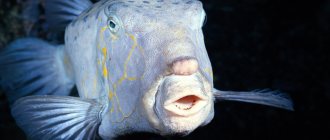Red guppies
This group can include all guppies that are red in color, but have a variable pattern - this is a solid red color, red blond guppy, red dragon guppy, red mosaic, red platinum, red-black, red Tuxedo, red Moscow, flamingo guppy, scarlet, red snakeskin, etc.
Red snake skin guppy
Red cobra guppy photo
Red dragon guppy photo
Super red guppy photo
Guppy red blond photo
Guppy flamingo photo
Classification according to the shape of fins and tail
Guppies differ from each other in their tail feathers. It can be of different shapes and lengths. For example, in the owners of the longest tail - spiny tails, it can be equal to the length of the fish’s body.
Based on the shape of the fins, the following classification is distinguished:
- flagtails;
- spinytails;
- spear-tailed;
- veil-tailed;
- double sword;
- round-tailed;
- spadetails;
- lyrebirds;
- top sword;
- lower sword;
- triangel (edged fantails);
- fantails;
- fantails acute-angled.
If we talk about fins, then in all fish representatives the dorsal fins are sharply raised at the base.
Guppies are black
This group includes black guppies under loud names such as: black monk, black prince, black tuxedo, black Moscow. The problem with this group is the difficulty of selectively retaining black tones. Therefore, good black specimens of guppies are highly valued by aquarists.
Guppy black monk photo
Black Moscow Guppy photo
Guppy black prince photo
Black Tuxedo Guppy photo
Guppy solid black photo
Varieties of guppies by color
All species are of selective origin. Thanks to constant crossbreeding, a large number of fish colors have been developed. There are not only single-color types, but also many color subspecies. Experienced aquarists prefer monochromatic specimens. They look more impressive in an artificial pond.
The classification of fish colors is as follows:
- Reds. One of the representatives of the species is the Red Moscow guppies. The body has a rich red color. The abdomen in the front and muzzle have a lighter shade.
- Orange. These include Orange Filigree. The scales and veil have a dark mosaic pattern.
- Yellow. Among these representatives, Endler's Gold guppies can be distinguished. The individual has yellowish scales. If sunlight hits an individual, the body begins to shimmer with a golden color.
- Green. A representative of this species is the Smaragd or emerald fish. The green body is covered with a mosaic pattern.
- Blue and light blue. This type includes Blue glass. The dove-colored fish has spots of blue and greenish tints. The blue color is also present in the edging of the “skirt”.
- Black. Among them, the Black Monk is distinguished. Its body is covered with black scales with a velvety blue tint.
- White. Among this species, Pearlescent White is popular. The scales of the fish have a pearlescent tint. Some varieties have a darker muzzle.
- Leopard fish have yellow scales. There are dark spots against this background.
- Neon ones are the most beautiful representatives. They stand out among their relatives with their bright shades and tints.
These are the main varieties of fish based on color. But there is a wide variety of shades.
Guppy green
Green cobra, green Moscow guppy, snake skin +++
Green Moscow guppy photo
Green snake skin guppy photo
Guppy green cobra photo
Breeding and reproduction
In guppies, it is quite easy to distinguish the female from the male: she is much fuller, larger and more modestly colored. Guppies are viviparous fish. The female does not lay eggs, but gives birth to independent fry that are capable of swimming and feeding. In order to prevent the fry from being eaten in a community aquarium, dense thickets of plants are necessary. Java moss and cabomba are excellent. It is best to place a pregnant female in a spawning aquarium. After the birth of the offspring, the mother should be removed from the children. The fry readily eat live nanofoods: Artemia nauplii and ciliates. Ready-made industrial dry food for fry is also suitable for them. Baby guppies grow very quickly and will soon be able to swim in a common school with their relatives.
Guppy yellow
This group includes all guppies with predominant yellow tones: yellow tuxedo, yellow cobra...
Yellow and then white, albino breeds, all these are xanthorist - aquarium discoloration mutations. Their breeders fix them genetically. Xanthorists are fish that are discolored by developing a yellow tint instead of red or green. Yellow guppies are xanthorista. White, albinos are super xanthorist freaks. All these are scientific terms without any hype. A freak is an individual with congenital body defects, possibly due to a genetic defect or exposure to negative factors in the embryonic period. And period.
And you say that GLO-fish is wow wow. Here, before Glo, how much wood humanity has chopped up, so mother, don’t worry.
Guppies yellow Berlin photos
Guppy yellow cobra photo
Yellow Tuxedo Guppy photo
Popular types
Despite the diversity of species, the following breeds of guppies are common and popular:
- The Red Blonde is of great interest among aquarists. It reaches 4-5 cm in length. The bright red color of the tail is combined with a whitish body and a white head. Hence the name of the species. There are animals interspersed with golden, light and dark colors.
- Among the representatives of guppies, the Blue Moscow ones stand out. The body of the fish has a turquoise color. And the scales shimmer with green and blue shades. Among Moscow animals there are animals with olive-colored spots. They are located on the back and muzzle.
- The Green Cobra is also distinguished. The body of the fish has a green tint with a gray tint. The scales resemble a cobra. In combination with spotted fins and tail, the guppy looks impressive. There is a plaque-shaped spot at the base of the head.
- The Black Prince is popular. It has an interesting double coloration. The head and abdomen in the front are silvery. Then it smoothly turns into a black shade. Females of this species have a paler hue, males look much brighter.
- A representative of the red species, the Red Dragon or Royal is also popular among aquarists. The fish is bright red in color. There may be spots of a darker or lighter shade on the body. Not only the body of a fish can be red, but also its eyes.
- Yellow German guppies are of interest. The color can be light shades or rich lemon. Despite the name, representatives may also have a white body. It can predominate over the entire abdomen or half.
- Endler's guppy is a leopard species. The color harmoniously combines shades of yellow and blue-gray. Males have a more saturated color. The fish differs from other representatives of guppies in its small size. On average it reaches 3 cm.
- Tuxedo or tuxedo fish looks impressive in an aquarium. The body has a double color: the front part is white, the tail part is black. The transition is clear. The color can have shades of red, yellow, green.
- The representative of the orange species is Carnation, also popular among lovers of artificial reservoirs. Her body can have several shades: white, orange, dark. The tail part is bright orange and complemented by several rows of vertical black dots. Its shape resembles the torn edges of a carnation.
- Despite the fact that the fish is expensive, Elephant Ears guppies attract aquarists. They earned love thanks to their bright tail. The body is silver in color with a bluish tint and topped with a bright orange caudal fin. It is diluted by black stripes. The shape of the tail is similar to an elephant's ear, hence the name.
These are the most popular representatives of guppies, but not the entire list of favorite fish species. Experienced aquarists and breeders raise elite guppies through crossing. They try to achieve richer colors, clearer patterns and larger sizes. Such representatives participate in international exhibitions.
White guppies
Albino guppy photo
White Moscow guppy photo
White platinum guppy photo
Conditions of detention
Guppy can be kept in both small (from 15 liters) and large community aquariums. We must remember that guppies need filtration and regular water changes. This fish is perfect for a beginner aquarist. Guppies are schooling fish that feel comfortable in the company of their relatives. The aquarium with them should be planted with plants so that the fish feel even more confident. Comfortable water parameters for them: temperature +22..+25 degrees, hardness from 10 dGH and above, acidity pH 6-7.5.
Guppy cobra
And finally, let’s highlight two more popular morphs of the common guppy, the qualification for which is the body pattern. Cobra guppies are all guppies with “snake skin”.
Guppy cobra blue photo
Guppy cobra green photo
Yellow cobra guppy photo
Red cobra guppy photo
Guppy Cobra Ceylon photo
Why doesn't the fry come
Yulia has an aquarium where females swim who did not become pregnant within the allotted time frame, but Yulia does not want to sell them for the same reason.
And recently, admiring one of these beauties who had already counted 9 months of her life, Julia decided to conduct an experiment and sent her to young three-month-old males, of which there were about 20 in the bank. Young and hungry males chased her from sunrise until late in the evening .
And, lo and behold, she became pregnant and gave birth to about fifty fry at the very first mark. And what’s interesting is that everyone is strong, well-matched, like a match, one to one. There were not a single unfertilized egg or dead fry in the mark, not even any snowbirds. Which generally contradicts the statements of many guppy experts that albino females cannot become pregnant after six months.
These are the three stories.
They have one thing in common - each breed, each female needs an individual approach; there is no general template for breeding pure-line selective guppies. There are general recommendations that should be followed, but this is not enough for complete success. Only through trial and error will you come to understand this process in relation to your wards.
But this, as shown in our examples, is also not at all a fact.
There are also opposite stories, when a seemingly complex fish is surprisingly easy to breed in our country.
For example, we now have ten breeds of albino guppies, some of them obtained and bred in our aquarium. And we do not experience any special problems with their breeding.
The only problem is that over time there is a need to renew the blood, and many aquarists, including us, have great difficulty with this matter. There are practically no purebred fish left in our country. You have to buy what you have and bring the fish to mind on your own. And this is a time-consuming and very labor-intensive process.
And it is easiest to accuse a fish breeder and breeder of dishonesty.
In the end, he is not a god, but just a man who is trying to comprehend God’s providence in creating a new life.
We, for example, believe that our task is to raise a healthy purebred fish, which, if you manage to breed it, will give you magnificent offspring, and they will be an exact copy of the parents, and not a hodgepodge of who knows what.
Yes, training and breeding livebearers of pure lines is not the easiest task, but at the same time it is a very interesting and exciting process.
The result is worth spending time, money and labor on.
Good luck to you, and remember, the road will be mastered by those who walk.











